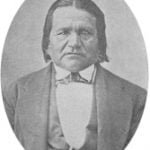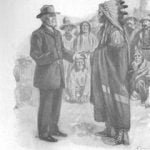
Far away near the Aravipa River in Arizona, one of “Uncle Sam’s” young officers rode at the head of a company of soldiers. They had marched eighteen miles already in a deep ravine, the bottom of which was filled with coarse sand. In the rainy season this ravine was filled with water, but now it was what the Mexicans call a ” dry arroyo, ” for there had been no rain for many weeks. Just at the mouth of this arroyo was the Aravipa River, coursing serpent-like across their path. It was not very broad nor very deep, but they were glad to see even a little water. The march had been a hard one. Every step in the sand was like walking in loose snow, and the mules which drew the baggage wagons were tired and did not want to go. At sight of the Aravipa River flowing along between bright green cottonwood trees, the mules began to bray loudly and to pull hard to get their noses into the stream. The soldiers broke ranks and ran up the river, each to get a good drink of clear water and fill his canteen. A short way beyond was a beautiful grassy meadow, and here the little company pitched their tents, naming their camp for the great leader who had become our President-Camp Grant. Now, six miles away from the cottonwood trees where the soldiers crossed the Aravipa River there was a deep cut or canyon. It was steep and high and rocky on one side, but so sloping on the other as to make a nice, safe sleeping place for a tribe of Indians. Here were beautiful springs of fresh water; the air was warm and the Indians made warm houses for themselves. First, they dug hollow places in the ground, lined with soft leaves or deer skins, and then protected these hollows from the sun by bushes or leafy branches laid across scrub trees, which grew to a considerable size on the cross ridges running to the bottom of the canyon.
This tribe of Indians is called “Aravipa Apaches,” and if the young officer had believed the reports he had read in the newspapers or heard from rough Mexicans he would have supposed them thieves and robbers. But he had not believed these stories, for he was a strong friend to the Indians, and when he was sent to protect the Indian Agent, who was afraid to live alone among them, so far from any soldiers, he made up his mind to find out what was the real truth. As soon as the camp was in order, he took a guard of six men with him and went to an old frame building a quarter of a mile down the river.
This was the Indian Agency. Of course, the Agent could not speak Apache, so he had a queer-looking little man, half Mexican, half Indian, to act as interpreter. This queer little man looked like a dark-skinned boy of twelve or thirteen, but had the husky voice of an old man, and was probably about twenty-five years old. He was called Concepcion.
When the young officer reached the Agency, instead of fearing to meet the Indians as the Agent had done, he told Conception to go into the canyon and ask the present chief of the Indians to come to the Agency for a talk. Conception said the old chief was Santos, but Eskiminzeen, his son-in-law, was the real chief. He would bring them both. True to his word, Conception returned with the two chiefs within two hours. Santos was a thickset, short-necked man, not very tall, but with a finely shaped head. His straight black hair was parted in the middle and cropped all around, so that the ends just touched his shoulders. He wore a common waistcoat over a poor shirt, open at the throat. A strip of cotton was around his waist, like a short skirt, and he had low beaded moccasins on his feet. Two strings of bright beads hung around his neck. The young officer took quite a fancy to him at once, in spite of this queer costume, for his eyes were mild and dark and looked friendly.
Eskiminzeen, Santos’s son-in-law, had his hair in two long braids and was fully dressed in skins. He wore rings in his ears and a, string of silver coins and little shells around his neck. In his hand was a small shawl, which he sometimes wrapped like a turban round his head.
At first, the young officer tried to talk through Concepcion to Eskiminzeen, but the chief was a stammerer and stuttered so badly that it was very hard to understand him, and at last Conception gave it up.
“Sir Lieutenant,” he said, “Eskiminzeen, no talk good, me no saucy!” (I don’t understand.)
“Try Santos,” said the young officer.
The chief raised his eyes and gazed steadily at the lieutenant, while he answered questions which were given through the interpreter.

He said that for a long time he was head chief of the Indians who now lived in Aravipa Canyon. They planted lands then, loved peace, and did not go on the war-path. When Tontos or Sierra warriors came, they fought them and drove them off, but they loved peace and when the enemy was beaten planted corn and other things once more. Then they hunted for deer and other game, stripped and dried the meat for food; gathered corn and did not go on the war-path. When Santos grew old he made this young Indian, Eskiminzeen, chief. It was he who brought Santos and the Aravipa Indians to this valley and to the canyon. Santos said it was a good place, a good house, and all the tribe had come. They had done no harm. Eskiminzeen never began a war, nor did he steal horses or cattle, or rob and kill white people. They intended to live quietly and happily, but one night the men had a big dance. They were so tired that they went to sleep where they had danced. The women and children went to sleep a short distance away from the men. While they were all asleep, before the sun was up, a big company of white men and Mexicans came up and fired their guns right at the women and children. Some were killed. Little boys and girls were hurt very badly, and a few of those that were army post. I first went to visit Chief Eskiminzeen and Santos with Conception. It was hard riding, and Concepcion went ahead of me, shouting: “All right, all right, bueno Generale !”
Under the shady cottonwood trees, where the arroyo and the river cross each other, I met white men and Mexicans (who brought many of the children taken away in the one sided battle) and many Indians. Santos became my devoted friend and helper. I told him that we had the same Great Father, so we must be brothers, and he took my hand and gave me his heart.
The great question was what to do with the captive children. The white people and Mexicans said it was much better for the children to stay with them in their Christian homes, but the Indians said: “They are our children and we love them and want them with us.” After many councils, I told them that the question must be settled by President Grant in Washington, and that in the meantime the children should stay at Camp Grant. Here the Indians could come and see them, and if the white people wanted to they might also visit and talk to them. This pleased everybody and all were satisfied. Santos took a small, hard stone and laid it before him on the level ground, saying: “As long as this stone shall last, there will be a good peace and no one will go on the war-path any more.” Then the Indians, Mexicans, and white people embraced each other and there was great joy.
Santos always carried with him a small book which I had given him. Of course, he could not read a word of it, but he never lay down to sleep without putting it under his head. He was the first Indian who agreed to go with me to Washington. At Santa Fe he was dressed like a white man, and from there we traveled many miles. Santos was deeply interested in everything he saw. The White House and the President made his heart beat faster. He was more silent than General Grant himself, but with beaming face he gazed upon the great leader as long as he could, and carried back to Eskiminzeen and his Indians an impression which he only could tell them about.
We traveled back by train to Pueblo, in Colorado. Then by an old-fashioned four-horse stage-coach to Santa Fe, and by horseback to Camp Apache. Here I left him, and my son, Guy Howard, then but sixteen years old, took a guard of soldiers and escorted him over the rough mountain trail to Camp Grant.
As Santos and Concepcion slowly rode through the Aravipa Canyon they were met with a shrill cry of joy. The cry echoed and reechoed from hilltop to hilltop for miles and miles, and must have reminded many of the time before when, hardly knowing what to expect, I entered the canyon and Conception, going before, cheered my heart with his high, shrill shout of “All right, all right, bueno Generale!”
